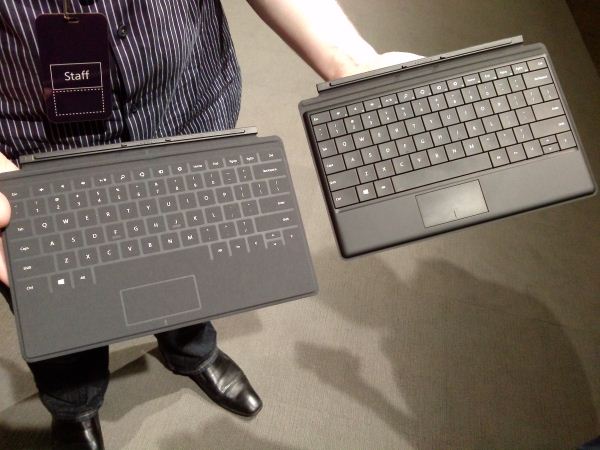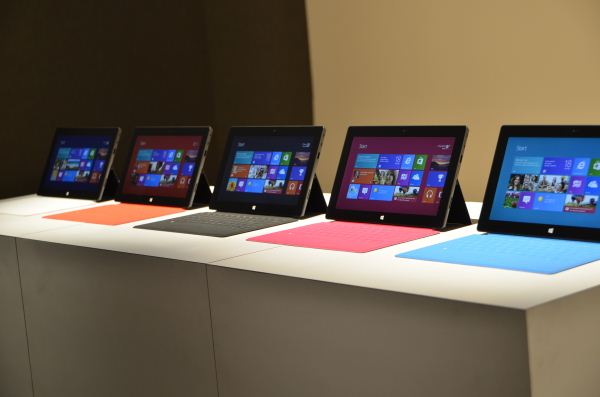Microsoft Surface - We Go Hands On [UPDATE: Detailed Impressions]
by Vivek Gowri on June 18, 2012 11:32 PM ESTPost-announcement, Microsoft took us to a backroom in Milk Studios to give us hands on experience with the Surface. They weren't lying, even the preproduction units feel awesome in hand. The magnesium panels are finished with partial vapour deposition, a process that deposits a thin-film coating onto the panel using vacuum deposition (molecule-by-molecule deposits at sub-atmospheric pressure.) It gives the unit a distinctly premium feel, and one that's pretty different from most of the other metal-bodied systems out there particularly with the current trends towards anodization and brushed finishes. The body is 9.3mm thick (a tenth of a millimeter thinner than the latest iPad), and total weight comes in at 676g (or about 1.49 lbs), so it's denser feeling than the iPad.. The 31.5Wh battery isn't as large as the iPad's 42.5Wh, but the 1366x768 10.6" LCD definitely draws less power.
The hinges in the kickstand are spring-loaded, giving a very positive mechanical feel and noise. The hinge mechanism is particularly robust, and as mentioned in the keynote, was acoustically tuned to sound high quality. Microsoft seemed particularly OCD about certain design details, this being one of them. It paid off though, with a hinge that looks and feels ready to take a lot of abuse. The stand props the system up at 22 degrees, which is a common theme - the beveled edges are all angled at 22 degrees, and the rear camera is also angled at 22 degrees in the opposite direction. This is a pretty interesting one, since it means you can keep the tablet angled as is usually comfortable, and still shoot video straight ahead. It's a good idea, though probably one that will take a bit of adjustment in real life use.
My personal favourite part of the Surface is the cover. There's two of them - the Touch Cover, and the Type Cover, both with integrated keyboards and touchpads. The Type Cover has a traditional keyboard, albeit one with particularly shallow feel, along with physically clicking mouse buttons. The Touch Cover is very interesting - it has a pressure sensitive membrane keyboard with felt keys and mouse buttons housed in a cover that's totally 3mm thick. (The Type Cover is ~5.5mm thick). I wasn't able to get a feel for how typing actually feels on it, so I can't comment on responsiveness or accuracy, but our friend Ben Reed at Microsoft Hardware swears he can top 50 words per minute on it any given day. I'm inclined to believe him, but I can't comment firsthand until I can actually play with a working unit.
The outside of the covers is covered in a felt material, and when closed, the unit feels like one of the velour or felt-covered journals. It gives a decidedly organic, natural feel to a very inorganic device, something that Microsoft was very pleased to note. It's a pretty awesome idea, actually, taking the best parts of Apple's Smart Cover and ASUS' laptop dock and merging them together into one of the most innovative cases we've seen. I took away three major things from this event, and the only one them that directly related to the device hardware being shown off was that integrating the keyboard into the cover was a stroke of awesome. (I'll go more in depth on the others in a larger post later today.)
For the first time, I can really see a tablet replacing a notebook as my primary computing device. Before today, I couldn't say that with any real conviction - I tried it with the iPad on multiple occasions, and it just didn't work. I'm a writer, tablets aren't ideal for writing. Surface changes that in a big way. And that's really what Microsoft is going for here - a device that fits into your life as a versatile tool to do anything you want it to. Whether they'll succeed in capturing the market is a story that will be told after Surface launches alongside Windows 8 later this year, but for now, this is a very promising start.




















161 Comments
View All Comments
runner50783 - Tuesday, June 19, 2012 - link
Although the iPad has a much higher res screen I believe is kind of an overkill... more pixels means less performance and even thus the iPad has the most powerful graphics processor on a tablet It can't really outperform the previous generation at native resolutions. With that, I will take an adequate resolution (going for the full HD version) which is more than sufficient for the purpose.Spunjji - Tuesday, June 19, 2012 - link
Agreed here. Apple's slavish adherence to quadrupling the pixels on a device when they upgrade resolution is absurd. 1024x768 was always a joke, but 2048x1536 is a joke in the other direction.mcnabney - Tuesday, June 19, 2012 - link
I am no Apple fan, but it looks amazing. And the GPU in the new iPad obliterates Tegra3.steven75 - Tuesday, June 19, 2012 - link
Windows fan says: "Apple made the screen look *too good*.LOL!
Belard - Tuesday, June 19, 2012 - link
Who needs multitasking, color graphics and stereo sound? Thats for games, not for real computing. - reference of MSDOS compared to Amiga back in 1985.2048x1536 looks gorgeous. Its higher than the 24" display I'm using now... and yet I can see the individual pixels on my screen. When using less than 1.5 feet away, the pixels are obvious on a "standard" tablet display.
When looking at photos with the iPad3, they become more "PHOTO-LIKE", no pixels. Text is crisper. It looks pretty damn good and the WHOLE industry is moving to catch up (for a reason) with desktops, notebooks, tablets and phones.
So yeah, it DOES MATTER... and it'll help push 4K to come out quicker.
kkwst2 - Wednesday, June 20, 2012 - link
Well, I liked the iPad 2, and I like the new iPad 3, and agree the screen is more crisp and looks great. It makes pictures look moderately better and text marginally better.However, the people on here claiming that they can't use an iPad 2 for reading text now sound like those twits from the 80's constantly fuddling with their equalizer trying to "flatten out" 20 kHz when any objective audiology exam would suggest they couldn't hear anything above 15 kHz becaue of all the loud music they listened to.
And the iPad is a mediocre device for reading text, easily outperformed by a $150 Nook SimpleTouch (or a $3 book). Pixel density is nice, but not everything.
AnnihilatorX - Tuesday, June 19, 2012 - link
Windows can't handle high res for text display. If you run 1080p on a 13" display the fonts would be unreadable, icons will be too small, changing the dpi destroys all legacy applications. it's not like Apple OSX, a closed system, which can and was patched to support high res displays by updating most applications in the ecosystem and the OS.Spunjji - Tuesday, June 19, 2012 - link
Windows 8 RT, which is what the lighter version of this will be running, is not going to suffer those problems re: DPI.BrooksT - Monday, June 18, 2012 - link
Remember that surprising news that WinRT licensing was running $85/device? And the gnashing of teeth that no WinRT tablet could be price-competitive with iPad with that licensing cost?Well, guess what? Microsoft doesn't *want* any OEM tablet to be competitive. Sure, you can build an ARM-based Windows tablet, take a $85/device license, and then try to compete with Apple on one side and Microsoft on the other. Or maybe you just shouldn't, since Microsoft has bigger scale, deeper pockets, and won't be out that $85.
Seems pretty clear that MS has decided to own the Windows tablet market, or at least the ARM-based tablet market. Combined with Metro and the Windows Store, this is a neck-snappingly quick adoption of Apple's vertical integration model.
ImSpartacus - Monday, June 18, 2012 - link
But time will tell if they will be successful with this new model. MS always seems to look promising when they leap into a new market, but it never seems to click. Aside from their titanic software business, their only clear success has been the Xbox. I don't mean that MS is financially unstable, only that they are not as agile as Apple.